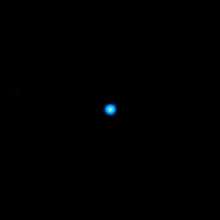RX J1242−11
RX J1242.6−1119A (often abbreviated RX J1242−11) is an elliptical galaxy located approximately 200 megaparsecs (about 650 million light-years) from Earth. According to current interpretations of X-ray observations made by the Chandra X-ray Observatory and XMM-Newton, the centre of this galaxy is a 100 million solar mass supermassive black hole which was observed to have tidally disrupted a star (in 1992 or shortly before).[1] The discovery is widely considered to be the first strong evidence of a supermassive black hole ripping apart a star and consuming a portion of it.[2]
| RX J1242−11 | |
|---|---|
 | |
| Observation data (J2000 epoch) | |
| Constellation | Virgo |
| Right ascension | 12h 42m 36.9s |
| Declination | −11° 19′ 35″ |
| Distance | 650 Mly (200 Mpc)[1] |
| Characteristics | |
| Type | elliptical |
| Notable features | Pair of Galaxies = [KG99] A + [KG99] B. |
| Other designations | |
| RX J1242.6-1119A | |
References
- Komossa, S.; Halpern, J.; Schartel, N.; Hasinger, G.; Santos-Lleo, M.; Predehl, P. (May 2004), "A Huge Drop in the X-Ray Luminosity of the Nonactive Galaxy RX J1242.6-1119A, and the First Postflare Spectrum: Testing the Tidal Disruption Scenario", The Astrophysical Journal Letters, 603: L17–L20, arXiv:astro-ph/0402468, Bibcode:2004ApJ...603L..17K, doi:10.1086/382046
- NASA: "Giant Black Hole Rips Apart Unlucky Star"
External links
This article is issued from Wikipedia. The text is licensed under Creative Commons - Attribution - Sharealike. Additional terms may apply for the media files.